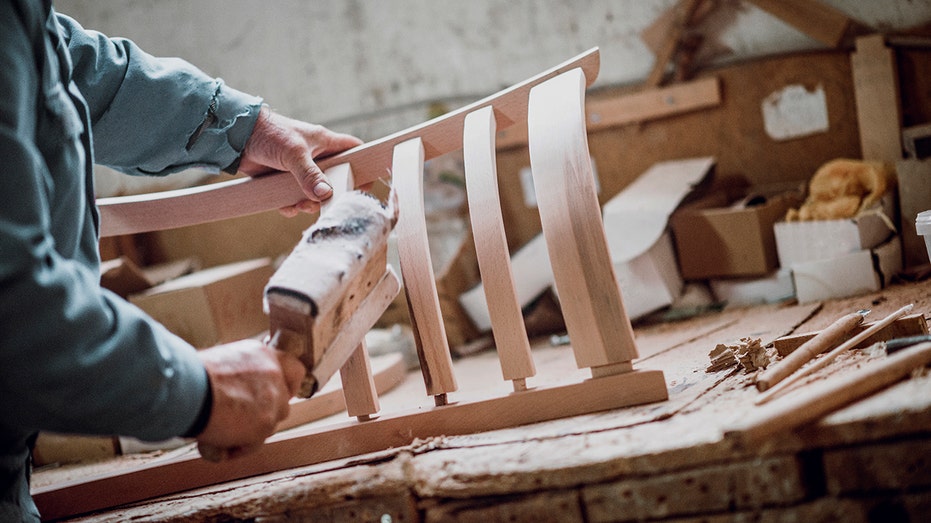Trade tensions are hitting home for American furniture manufacturers.
While 52% of the U.S.’ $1.9 trillion in domestic furniture sales come from goods made in America, many companies still rely heavily on overseas partners – especially in Asia – for critical components. Even manufacturers with U.S.-based mills and production facilities are feeling the pressure from an increasingly global and volatile supply chain.
Take Valdese Weavers, for instance – a North Carolina-based upholstery fabric supplier whose clients include Arhaus and Restoration Hardware. While 80% of its production is proudly domestic, President Blake Millinor told FOX Business the company still sources yarn components from 17 countries.
“We do use imported components that received tariff treatment, whether it’s India, Turkey or elsewhere,” Millinor said.
TRUMP CLOSES TARIFF LOOPHOLE ON CHEAP ONLINE GOODS FROM CHINA
Tariffs on Chinese imports – some as high as 145% under President Donald Trump – have driven costs up dramatically, with Chinese fabric prices rising 20% to 50%, according to Millinor.
Despite ongoing efforts to “reshore” manufacturing, the reality is complex. As of 2023, only 52% of consumer furniture purchases were made in the U.S., according to the U.S. International Trade Commission. China remains the largest source of imported furniture at $12.6 billion, followed closely by Vietnam at $12 billion.
Why American-made furniture needs the world
At Vaughan-Bassett, a legacy bedmaker headquartered in Virginia and North Carolina, most wooden furniture is crafted domestically, using raw materials sourced within a 250–300-mile radius. However, even CEO Wyatt Bassett admits some inputs – like hardware, finishes and packaging – are still imported.
“For a couple of metal imports, we’re a little bit at the mercy of who we can source them from. About 5% of components come from Asia – mostly China,” he said.
WALMART SUPPORTS SMALL BUSINESSES, AMERICAN-MADE PRODUCTS THROUGH NEW ‘GROW WITH US’ INITIATIVE
Similarly, Century Furniture, part of the Rock House Farm Family of Brands, manufactures entirely in the U.S. but still relies on foreign suppliers for specialized materials like acrylic and metal components. According to CEO Alex Shuford, that is not by choice – it is about availability.

“China’s the best country for acrylic these days until somebody stands up with factories that can do what they do,” he said.
Century recently implemented a product surcharge to offset new tariffs on imported Chinese components. One example: a table comprising a Chinese acrylic base, a metal collar from Vietnam and a wood top made in the U.S. – with the Chinese portion driving the price hike.
The political spotlight and the path forward
Trump has recently drawn attention to North Carolina’s historic role in furniture manufacturing, saying that the region’s industry was “wiped out” by offshoring but could rebound.
“Thousands of companies are going to relocate back into the United States and North Carolina,” Trump said. “Already, furniture people are starting to move back in.”

Millinor said ambition is possible – but tempered by reality.
“We’re in a position to increase our production. We have the labor. We have the equipment. And that’s the case for a lot of domestic fabric and furniture manufacturers,” he said.
Bassett agreed. “We’re working well below capacity. If volume returns, we can scale up quickly.”
HOW TRUMP’S TARIFFS CLOSED THE LOOPHOLE USED BY CHINESE RETAILERS
However, not everyone is convinced that revival will be quick or easy. Twenty-eight textile mills closed in the past year alone, and dozens more over the past two decades, according to the National Council of Textile Organizations. For many in the industry, the uncertainty of U.S. trade policy is the biggest roadblock to investment and growth.
A demand surge meets strategic paralysis
At STI Fabrics, home of the Revolution Performance Fabric brand, demand is surging, but CEO Sean Gibbons is hesitant to greenlight expansion due to unclear policy direction.
“We have significant excess capacity. We could more than double our current output,” Gibbons told FOX Business correspondent Gerri Willis on “The Big Money Show.” “But we’d need 100 more workers just to meet current customer demand from brands like Room & Board and Pottery Barn.”

STI, which has been operating since 1964, now finds itself one of only four competitors still standing in the Carolinas – a steep drop from the dozens that operated just 20 years ago.
“We still make things in the United States,” Gibbons said. “But the next administration could change everything again. That’s what makes investing so hard.”
Industry at a crossroads
At this year’s High Point Furniture Market, the largest and oldest furniture trade show in the U.S., the mood was a mix of resilience and caution. With the latest round of tariff announcements fresh in attendees’ minds, retailers, manufacturers and distributors gathered not just to showcase goods, but to rethink sourcing strategies and supply chain dynamics.
Ben Muller, the vice president of marketing for High Point Market Authority, said that international buyer company traffic decreased significantly this year – 14% – as a result of geopolitical turmoil.
As companies grapple with geopolitical risks, cost pressures and evolving consumer expectations, one thing is clear: the future of American furniture lies at the intersection of domestic revival and global interdependence.
FOX Business correspondent Gerri Willis contributed to this report.
Read the full article here











